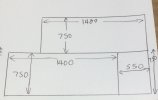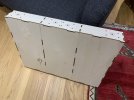The assembly of the Grainge & Hodder base-boards for ‘Rowan Colliery’ has commenced. Today.
I had intended to make a start ‘during the Christmas holiday’, so I am a little late. There are to be three base-boards:

The sizes chosen are designed to minimise the number of tracks (ideally just one) crossing the joints between the different boards. However, I think there will have to be two tracks across the join between the two ‘front’ (scenic) boards — the main circuit and a head-shunt. Otherwise the head-shunt will be very short and severely limit train length in/out of the sidings on the main scenic board.
As this is a learning experience for me, I have started with the small board:

The main structure is complete.
I have also ordered some more of the track I will need. I will start track laying though with the FY board, the assembly of which is not yet begun.
I had intended to make a start ‘during the Christmas holiday’, so I am a little late. There are to be three base-boards:

The sizes chosen are designed to minimise the number of tracks (ideally just one) crossing the joints between the different boards. However, I think there will have to be two tracks across the join between the two ‘front’ (scenic) boards — the main circuit and a head-shunt. Otherwise the head-shunt will be very short and severely limit train length in/out of the sidings on the main scenic board.
As this is a learning experience for me, I have started with the small board:

The main structure is complete.
I have also ordered some more of the track I will need. I will start track laying though with the FY board, the assembly of which is not yet begun.



